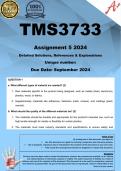TMS3733
Assignment 5 2024
Detailed Solutions, References & Explanations
Unique number:
Due Date: September 2024
QUESTION 1
a. What different types of material are needed? (2)
1. Raw materials specific to the product being designed, such as metals (steel, aluminum),
plastics, wood, or fabrics.
2. Supplementary materials like adhesives, fasteners (nails, screws), and coatings (paint,
varnish).
b. What should the quality of the different materials be? (2)
1. The materials should be durable and appropriate for the product's intended use, such as
high tensile strength for metals or flexibility for certain plastics.
2. The materials must meet industry standards and specifications to ensure safety and
performance.
Terms of use
By making use of this document you agree to:
• Use this document as a guide for learning, comparison and reference purpose,
• Not to duplicate, reproduce and/or misrepresent the contents of this document as your own work,
• Fully accept the consequences should you plagiarise or misuse this document.
Disclaimer
Extreme care has been used to create this document, however the contents are provided “as is” without
any representations or warranties, express or implied. The author assumes no liability as a result of
reliance and use of the contents of this document. This document is to be used for comparison, research
and reference purposes ONLY. No part of this document may be reproduced, resold or transmitted in any
form or by any means.
, +27 67 171 1739
QUESTION 1
a. What different types of material are needed? (2)
1. Raw materials specific to the product being designed, such as metals (steel,
aluminum), plastics, wood, or fabrics.
2. Supplementary materials like adhesives, fasteners (nails, screws), and
coatings (paint, varnish).
b. What should the quality of the different materials be? (2)
1. The materials should be durable and appropriate for the product's intended use,
such as high tensile strength for metals or flexibility for certain plastics.
2. The materials must meet industry standards and specifications to ensure safety
and performance.
c. What are the sizes of the available raw materials? (3)
1. Standard sheet sizes for materials like metal or wood (e.g., 4x8 feet for
plywood).
2. Rod or bar lengths for metals, often available in sizes like 6 feet or 12 feet.
3. Rolls or lengths for fabrics or plastics, typically available in specific widths (e.g.,
1-meter width).
d. Will the different materials have to be cut to size? (5)
1. Yes, many raw materials will likely need to be cut to fit the specific dimensions
of the product.
2. Sheets of metal or wood may need to be trimmed to create parts.
3. Rods and bars will require cutting to appropriate lengths for assembly.
4. Fabrics and plastics may need to be measured and cut based on design
specifications.
5. Precise cutting techniques, such as laser cutting or saws, may be required
depending on the material.
e. Will the different materials have to be shaped? (5)
Disclaimer
Extreme care has been used to create this document, however the contents are provided “as is” without
any representations or warranties, express or implied. The author assumes no liability as a result of
reliance and use of the contents of this document. This document is to be used for comparison, research
and reference purposes ONLY. No part of this document may be reproduced, resold or transmitted in any
form or by any means.
, +27 67 171 1739
1. Yes, certain materials will need to be shaped to meet design requirements.
2. Metals may require processes like bending, forging, or casting.
3. Plastics could involve molding, extrusion, or heating to shape.
4. Wood may need to be carved or planed to achieve specific forms.
5. Fabric could require stitching, folding, or sewing to attain the desired shape.
f. What does the final finish of the product or prototype have to be? (3)
1. The final finish should be aesthetically pleasing and match the design
specifications.
2. It should include treatments like painting, polishing, or varnishing to protect the
product from wear or environmental damage.
3. The finish should ensure that all components are smooth and free from defects
such as sharp edges or rough surfaces.
QUESTION 2
Grade 7 wooden bookshelf model:
a. Indicate the grade the model is planned for.
• Grade 7 learners
b. What are the different tasks that need to be performed?
1. Design and measure the bookshelf
2. Cut wood to size
3. Sand and smooth edges
4. Assemble the frame
5. Paint or varnish the bookshelf
6. Attach shelves and brackets
c. Which tasks need to be completed before another task can begin?
Disclaimer
Extreme care has been used to create this document, however the contents are provided “as is” without
any representations or warranties, express or implied. The author assumes no liability as a result of
reliance and use of the contents of this document. This document is to be used for comparison, research
and reference purposes ONLY. No part of this document may be reproduced, resold or transmitted in any
form or by any means.




